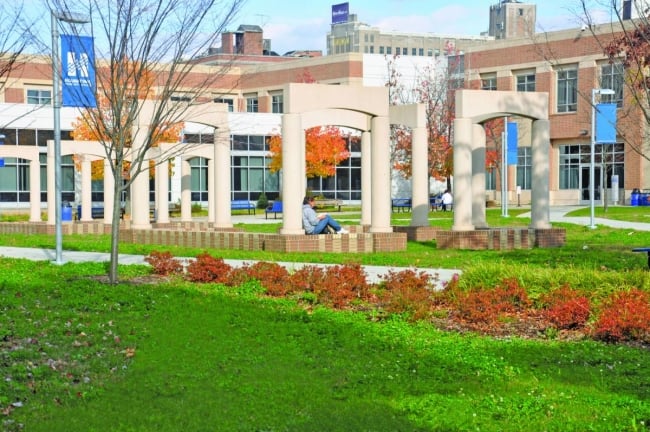You have /5 articles left.
Sign up for a free account or log in.

Connecticut State Colleges and Universities
The merger of Connecticut’s 12 community colleges can move forward after the regional accrediting commission approved a plan by the Connecticut State Colleges and Universities system to merge the community colleges and transform them into one college with a dozen campuses.
Under the proposed plan—approved Tuesday despite long-standing and vehement opposition from some faculty and staff members—the two-year colleges in the state’s public higher education system will become Connecticut State Community College by July 2023.
System leaders celebrated the news, which they said had been a long time coming. Officials first proposed the consolidation to the New England Commission of Higher Education in 2018, but the accreditor was not satisfied with the initial merger plans at the time.
“All of us within this system take great pride in our 12 unique colleges in every corner of the state, each of which is a cultural, educational, and economic hub,” Terrence Cheng, president of the Connecticut State Colleges and Universities, said in an email to employees and students. “But the merger is responsive to the harsh realities that community colleges face—a steady enrollment decline, lagging student success metrics, and an unsustainable financial trajectory.”
Many faculty and staff members remain unconvinced by assurances that the merger is the right solution and submitted testimony about the merger in a prescheduled public hearing held by state lawmakers Tuesday. The speakers told members of the Higher Education and Employment Advancement Committee of the state General Assembly that they favored proposed legislation to require state lawmakers to have oversight over—and potentially stop—the merger.
The accreditor’s approval strengthens administrators’ argument that the merger should go through, but “meeting the bare minimums of accreditation is far from designing a better system,” said Seth Freeman, president of the Congress of CT Community Colleges, the union for staff and faculty members, and a professor of computer information systems at Capital Community College in Hartford. “I resoundingly still feel that this is going to harm community college students across our state and that Connecticut State is not the answer to the real problems that are being faced in our system.”
Enrollment at the state’s community colleges has been decreasing for over a decade, and that decline has only been exacerbated by the pandemic. Student head count was 37,116 in fall 2021, compared to 58,253 in fall 2010. Two of the system’s community colleges have negative reserves. Cheng told Inside Higher Ed he believes some colleges would need to close because of financial strains if not for the merger.
Freeman acknowledged the system’s problems but believes administrators are too focused on “finding efficiencies at the detriment of the student experience.”
He said the merger means decisions about curriculum, hiring and other issues will be in the hands of “a massive, what we consider to be really bloated, statewide management,” rather than local college leaders with input from their faculty and staff members, who work most closely with students.
“The colleges are losing our autonomy, our individuality, and what we have been seeing is this big kind of monolith, kind of one-size-fits-all system is being designed,” he said.
Freeman also fears the consolidation will divert financial resources to the newly centralized administration from already underresourced individual colleges and lead to downsizing and understaffing. He noted that employees are already stretched thin because administrators haven’t replaced staff members who retired. He believes student enrollment and retention rates are going to suffer as a result.
“Our students want to have a full college experience where they have relationships with the faculty and staff at their college, where faculty and staff are there and present for them,” he said. “Cutting is never really going to be the solution. We can’t cut our way to improve student experiences.”
Cheng said he empathizes with staff and faculty members concerned about a loss of local authority and staffing changes.
“We have to give those faculty and staff who have dedicated their professional careers, their lives to their institutions … the space to mourn the fact that their institutions are going to change,” he said. “But at the same time, I think many faculty and staff recognize that the change is for the betterment of our students, it’s for the betterment of our state and our communities.”
Cheng insisted the merger will benefit students by streamlining their educational experience—with a unified curriculum, their credits would count across campuses—and by allowing them to take advantage of systemwide supports and opportunities, such as guided-pathway counseling and internships.
“With 12 individual institutions, you have 12 sets of rules, 12 sets of standards, 12 sets of barriers and so forth,” he said. “We’re going to be able to basically create balance in terms of resources and parity across campuses in a way that we could not before, which will certainly help in the equity arena … The needs, functionality and operations of each campus might be a bit different, but that said, the standards, the quality, the policy, the procedures, the protocols of what and how and why we do things, those should be ubiquitous.”
As far as Cheng knows, no other state community college system has embarked on a merger this big.
“To our knowledge, this is one of the most ambitious, most audacious attempts to really address significant concerns that we have about student outcomes, success, and also try to deal with some of the financial challenges,” he said.
Michael B. Horn, co-founder of the Clayton Christensen Institute, a nonprofit think tank, said the Connecticut system is “unique in that it’s the first of the New England states to move forward with such an expansive consolidation” among community colleges.
Nonetheless, Horn, who regularly writes about innovation and disruption in education, sees the merger as part of a trend in higher education. He noted that states like Louisiana and Georgia have merged community colleges in the past. Other community college systems, including in Vermont and New Hampshire, previously considered similar moves as an impending drop in the number of traditional college-age students, a so-called demographic cliff, looms in the region.
Mergers and closures of higher ed institutions tripled starting in the 2010s relative to the prior decade and show no sign of slowing, he said. For example, last year, the Pennsylvania State System of Higher Education approved plans to merge six universities. Campuses in the University of Maine system pursued a unified accreditation in 2020.
Horn suspects more community college systems will follow Connecticut’s lead.
“I think a lot of places will be looking to see what happens with Connecticut—does it achieve its aims, what are the benefits and what are the downsides,” he said. “I think it will become a case study, given the scope of it.”





